Guangzhou SightseeingVisit Guangzhou's Landmarks and Immerse in Chinese Culture Guangzhou is regarded as one of the twenty-four famous historical and
cultural cities in China.
In the late of the Qing Dynasty (1644-1911), a man named Chen got the third place in the highest imperial examination and had conferred upon him a distinguished office title which made the Family Chen well-known. Later someone suggested that all the Chen's families raise money to build a temple to sacrifice to the ancestors and encourage their offspring likewise to study hard. Therefore, the temple was finished in 1894 with the money donated by Chen's families in 72 counties of Guangdong Province as well as some overseas members of Family Chen. The temple is a compound complex consisting of nine halls, six courtyards and nineteen buildings connected by corridors, all separated by walls from the outside world. A pair of stone drums in front of the entrance door, measuring 2.55 meters (about 8.36 feet) in height and two colored drawing pictures of door-god of 4 meters (about 13 feet) in height are said to be the best in Guangdong. Opening Hours:8:30 am - 5:20 pm
The White Cloud Mountain is made up of 30 odd peaks. The highest peak, Moxing Ridge (Star-Scrapping Ridge) stands in the center of White Cloud Mountain, measuring 382 meters high, reputed as "the First Peak under the Southern Sky". There are sports, water slides, a golf course, botanical gardens, and a sculpture park that have been set up to attract tourists. Tourists can take a cable car to reach the top of the mountain.
Opening Hours: 6:30 am 5 pm
The Seven Star Crags is located on the northern outskirts of Zhaoqing city of Guangdong Province. Seven limestone crags stand in the formation of "the Plough" by the blue lake, hence the name of "Star Lake". The lake area measures 8 square kilometers with the seven crags of similar sizes closely arrayed. Seen from afar and at a height, the Crags encircled by a vast expanse of lovely waters resemble "The Big Dipper" inlaid upon the boundless Milky Way, inducing fantastic reveries. The lakeside Crags overgrown on their southern sides with dense evergreen
sub-tropical
plants are typical of the South China landscape. The lake scenic
The Shuangyuan Cave, 320 meters deep, has northern and southern exits, and is gifted with stalactites of various shapes. Tourists are able to visit the Caves in a boat. The Seven-Star Crags is famous for its lush mountain, exquisite waters, perilous cliffs and fascinating caves.
During the Opium War it was seized by British and French troops. As a memento of that period, two Krupp cannons are displayed at the entrance. Zhenlailou functioned again as a lookout tower during the 1911 Revolution. In 1953, it was converted into the home of the Guangdong Historical Museum, which exhibits and describes the history of Guangzhou, from Neolithic times till the early part of this century.
The Dr. Sun Yat-Sen Memorial Hall, situated on the southern slope of Yuexiu Hill, was constructed between 1929 and 1931 and is a monument to Dr Sun Yat-Sen, the forerunner of Chinese democratic revolution. The memorial hall is the most important relic in Guangdong Province, occupying an area of 12,000 square meters and a height of 46 meters. It has magnificent exterior and interior decorations. The whole building, octagonal in shape, is designed with traditional Chinese architecture. The memorial theater with its blue tile roof seats 5,000 people, and is used for rallies and cultural performances and is a key venue for the city's large-scale meetings and performances as well. In the hall, there is also a gallery showing pictures and letters of Dr. Sun Yat-Sen. A bronze statue of Dr. Sun Yat-Sen was set up in 1956 in front of the memorial hall. Opening Hours:8 am 6 pm
The tomb is situated on the Xianliu Road, about 3 kilometers (2 miles) east of Yuexiu Gongyuan Park. It was erected in 1918 and is surrounded by a park. On the arch at the southern entrance are to be found Dr. Sun Yat-Sen's words of "Eternal Glory". Behind the statue are blocks with the names and locations of the many various overseas Chinese communities who contributed to the memorial. The park also contains an obelisk, pavilion and pyramid-shaped building. The upper section of which consists of 72 stone slabs representing the 72 martyrs.
Opening Hours: 9 am 5:30 pm
More animal features have been introduced in the zoo, such as Guangzhou Ocean World, Insect & Butterfly Garden, Goldfish Garden and exciting Animal Performances. Apart from these attractions, fast food, Chinese cuisine, shops, a souvenir shop and the amusement park give visitors a place to relax and enjoy themselves.
Located on the west of Liuhu Lake, the Orchard Garden is a small park featuring many orchids. The garden grows more than 10,000 pots of orchids in over 100 varieties. With trees and flowers and winding paths, the park presents a scene as beautiful as a painting.
Shamian in Chinese means a "sand surface" and Shamian Island is connected to the rest of city by a series of bridges. From the 18th until mid of the 19th century, Shamian Island was the only place where foreign traders were permitted to set up their warehouses and factories. The land was expanded to 27,000 square meters, 900 meters from east to west, and 300 meters from north to south. Shamian Island is representative of Guangzhou's colonial history. It became a British and French concession after they won the Opium Wars. The island is covered by colonial buildings consisting of trading offices and residences. The French Catholic Church can be found in the main boulevard. The boulevard itself is a gentle stretch of garden, trees, and birdsong. Today, most of the buildings are used as offices or apartments blocks. Along the river, the park area is a great place to take a rest and drink a cup of tea. Or you can walk along the wide sidewalks and dine in the open-air under the old trees.
The South China Botanic Garden (SCBG) is located in Long Dong, 15 kilometers northeast of Guangzhou. The topography, lower subtropical monsoon climate, and ample rainfall make the garden an ideal place for plant acclimatization. Established in 1956, the SCBG has more than 6,000 species of tropical and subtropical plants.
Situated in the heart of Guangzhou city, the Six Banyan Tree Temple is a renowned Buddhist cultural site. Originally called the Baozhuangyuan Temple, it was renamed in the Ming Dynasty (1368-1644) as Six Banyan Temple. The temple has six banyan trees in the courtyard. It is also known as Liu Rong Temple among Chinese people. Built in 537, covering an area of over 7,000 square meters, the temple features 57.6 meters high Flower Pagoda, the tallest old structure in Guangzhou. Built in the Liang period of the Southern Dynasties, the pagoda has 9 storey's viewing from the outside and 17 storey's viewing from the inside. The top story of the pagoda houses a famous 5 thousand ton Buddha, copper pillar casted in the Yuan Dynasty (1271-1368). Visitors can climb to the top of the pagoda to see the full view of Guangzhou city. The main hall of the temple enshrines three giant statues of Buddha built in 1663. Each of them is six meter high, 10 ton in weight. They are the largest bronze Buddha statues in Guangdong.
Situated in Miaotou, Huangpu District of Guangzhou city, covering an area more than 30,000 square meters, this 1410 years old Temple of Southern Sea God is the only one left from the four ancient Sea God temples in China. The temple is an important site for it witnessed the history of ancient Maritime Silk Road in old China. The temple was established in 594 by Emperor Wen from Sui Dynasty, who started a major extension of China's canal network. The temple was the right place to pray for safety and smooth sailing. In Ming and Qing Dynasties (1368 1911 AD), Maritime Silk Road had reached Europe and America. Many precious stone tablets tell us the stories about overseas trade via Marine Silk Road and Guangzhou's history. The main attraction is a stone tablet over the gateway, represented the strong desire of seamen "not a wave roaring in the sea".Other relics include a bronze drum from East Han Dynasty (25 220 AD), an iron bell from Ming Dynasty and the carved jade sea. The temple was expanded and renovated several times since Tang Dynasty (618-907 AD). There are five parts in the temple: Gate, Ceremony Gate, Protocol Pavilion, Grand Hall and Rear Hall.
The mosque is one of the earliest mosques constructed since Islam came into
China in the seventh century. Legend said the mosque was built in around 627
from money donated by an Arab merchant who was a follower of Aibi Wankesu,
a famous Arab missionary. The mosque age is more than 1,300 years old and
was built in commemoration of Islam's founder - the Prophet Mohammed. The mosque is located on Guihua Ridge in Guangzhou. Apparently, there is a tomb of famous Muslim missionary who died in Guangzhou during the Tang dynasty (626-649 AD). The mausoleum likens to an ancient temple, with walls surrounding its four corners. There are two courtyards inside the mausoleum. The front courtyard consists of halls for religious services, big pavilions, side-rooms; while the back courtyard consists of Wankesu's coffin chamber, as well as the Moslem burial ground and Moslem cemetery.
The Sacred Heart Cathedral in Guangzhou City is described as the largest Gothic
Church in China. The cathedral is also known as "Shi Shi" (Stone-Chamber)
because all its walls and poles are made of granite.
The Chime Long Safari Park is located in Panyu, Yinbin Road and is home to the Xiangjiang Safari Park, Chime-Long Night Zoo, Crocodiles Park, Chime-Long International Circus, and Chime-Long Paradise. Xiangjiang Safari Park Chime-Long Night Zoo Chime-Long Paradise Address: Yingbin Road, Panyu, Guangzhou NOTE: Although this information is correct at the time of our web publication, it is still advised that you call the phone number and confirm the address before going to the venue because some venues may have changed their telephone numbers or address locations. |

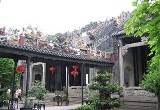 The Ancestral Temple of the Chen Family, also called Chen Clan
Academy, is a place for both worshipping ancestors and study.
The Ancestral Temple of the Chen Family is
famous for its exquisite craftsmanship including wood, stone,
and brick carving, as well as metalwork using copper and iron,
and wonderful murals. As for the carving techniques, both realistic
and imaginative styles were employed to give the temple a magnificent
yet solemn atmosphere.
The Ancestral Temple of the Chen Family, also called Chen Clan
Academy, is a place for both worshipping ancestors and study.
The Ancestral Temple of the Chen Family is
famous for its exquisite craftsmanship including wood, stone,
and brick carving, as well as metalwork using copper and iron,
and wonderful murals. As for the carving techniques, both realistic
and imaginative styles were employed to give the temple a magnificent
yet solemn atmosphere.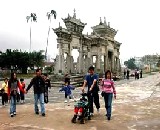 The
White Cloud Mountain is a park with natural hills and waters, and an ideal
sightseeing place and summer resort.The name White Cloud Mountain was given
because it appears that there are "white clouds flying over the mountain,
and which gathers around its base". Since the ancient times about 1000
years ago, this place became popular due to its gorgeous scenery and now carries
an abundant amount of historical relics.
The
White Cloud Mountain is a park with natural hills and waters, and an ideal
sightseeing place and summer resort.The name White Cloud Mountain was given
because it appears that there are "white clouds flying over the mountain,
and which gathers around its base". Since the ancient times about 1000
years ago, this place became popular due to its gorgeous scenery and now carries
an abundant amount of historical relics. 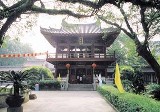 The
Bright Filial Piety Temple (Guangxiao Si),located at
Guangxiao Lu, is the oldest and largest Buddhist temple in the
Lingnan Area of Guangzhou. It was originally the residence of
the Nan Yue Kings, but became a temple in 401AD. During the Tang
Dynasty, Huineng, the monk who founded the southern sect of Buddhism,
studied here. In 1629 it was rebuilt after a fire, with new prayer
pavilions added. The Bright Filial Piety Temple plays an important
role in Chinese Buddhism history.
The
Bright Filial Piety Temple (Guangxiao Si),located at
Guangxiao Lu, is the oldest and largest Buddhist temple in the
Lingnan Area of Guangzhou. It was originally the residence of
the Nan Yue Kings, but became a temple in 401AD. During the Tang
Dynasty, Huineng, the monk who founded the southern sect of Buddhism,
studied here. In 1629 it was rebuilt after a fire, with new prayer
pavilions added. The Bright Filial Piety Temple plays an important
role in Chinese Buddhism history. spots include seven crags, eight caves, and six ridges. Each of the caves
has different characteristics: some are deep, tortuous and pitch-dark;
some brightly-lit with their entrances located halfway down from the crag
tops, and others filled with clear waters and cold draughts. Among them
the most famous are Heiyan Cave and the Shuangyuan Cave, formed by erosion
of limestone by ground waters which are interlinked with outside lake waters
and never dry up.
spots include seven crags, eight caves, and six ridges. Each of the caves
has different characteristics: some are deep, tortuous and pitch-dark;
some brightly-lit with their entrances located halfway down from the crag
tops, and others filled with clear waters and cold draughts. Among them
the most famous are Heiyan Cave and the Shuangyuan Cave, formed by erosion
of limestone by ground waters which are interlinked with outside lake waters
and never dry up. 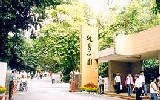 YuexiuPark is
the largest park in Guangzhou and gets its name from Yuexiu Mountain. Created
in the 1950s, the park is located in northern part of Guangzhou and covers
an area of 93 hectares. The Park contains an exhibition hall, stadiums, swimming
pools, and a few artificial lakes for boating. The park is very famous for
its Zhenhai Tower, which is the site of the Ming Dynasty City Wall, the Square
Cannon Site, and the Sculpture of the Five Rams.
YuexiuPark is
the largest park in Guangzhou and gets its name from Yuexiu Mountain. Created
in the 1950s, the park is located in northern part of Guangzhou and covers
an area of 93 hectares. The Park contains an exhibition hall, stadiums, swimming
pools, and a few artificial lakes for boating. The park is very famous for
its Zhenhai Tower, which is the site of the Ming Dynasty City Wall, the Square
Cannon Site, and the Sculpture of the Five Rams. 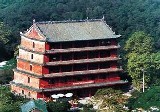 A
top the highest hill in Yuexiu Park in the northern suburbs of Guangzhou stands
the 28 meters high five-story red pagoda called Zhenhailou. It is a magnificent
building where one can get a bird's eye view of the whole city.The temple was
built on the order of Zhu Liangzu, the Yongjia Marquis of the Ming Dynasty
(1368-1644), to flaunt his power and to show that he was able to 'shake the
seas and mountains'. It was restored after a fire in 1686 to serve as a watchtower.
A
top the highest hill in Yuexiu Park in the northern suburbs of Guangzhou stands
the 28 meters high five-story red pagoda called Zhenhailou. It is a magnificent
building where one can get a bird's eye view of the whole city.The temple was
built on the order of Zhu Liangzu, the Yongjia Marquis of the Ming Dynasty
(1368-1644), to flaunt his power and to show that he was able to 'shake the
seas and mountains'. It was restored after a fire in 1686 to serve as a watchtower. 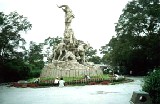 Also
in Yuexiu Park are the stone sculptures of the Five Rams. The sculptures were
carved out of granite in 1959. Legend has it that there were once five hermits
who took many rams, each with an ear of rice in its mouth to Guangzhou, where
they prayed for the extermination of famine. After that the hermits flew up
to the sky and the five rams turned into the fossils. For this, Guangzhou
is sometimes referred to as "Goat Castle" or "Rice Castle".
Also
in Yuexiu Park are the stone sculptures of the Five Rams. The sculptures were
carved out of granite in 1959. Legend has it that there were once five hermits
who took many rams, each with an ear of rice in its mouth to Guangzhou, where
they prayed for the extermination of famine. After that the hermits flew up
to the sky and the five rams turned into the fossils. For this, Guangzhou
is sometimes referred to as "Goat Castle" or "Rice Castle". The Yellow Flower Memorial Park in Guangzhou is the site of the 72 Martyrs
Mausoleum. The tomb of the 72 Martyrs on the Hill of the Yellow Flowers commemorates
those who lost their lives during the revolutionary uprising led by Dr. Sun
Yat-Sen against the Qing government on April 27, 1911.
The Yellow Flower Memorial Park in Guangzhou is the site of the 72 Martyrs
Mausoleum. The tomb of the 72 Martyrs on the Hill of the Yellow Flowers commemorates
those who lost their lives during the revolutionary uprising led by Dr. Sun
Yat-Sen against the Qing government on April 27, 1911. 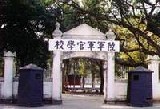 On Changzhou Island is the famed Whampoa Military Academy, which was founded
by Dr. Sun Yat-Sen in 1924 and which was attended briefly by Mao Zedong in
the 1920s. Guangzhou also contains the Dr. Sun Yat-Sen Memorial Hall, where
Sun gave lectures to the likes of Mao and Zhou Enlai.
On Changzhou Island is the famed Whampoa Military Academy, which was founded
by Dr. Sun Yat-Sen in 1924 and which was attended briefly by Mao Zedong in
the 1920s. Guangzhou also contains the Dr. Sun Yat-Sen Memorial Hall, where
Sun gave lectures to the likes of Mao and Zhou Enlai. The
Western Han Dynasty Nanyue King Mausoleum Museum is located on Jiefang North
Road. It is the oldest and largest Han tomb with the most funerary objects
in the Lingnan area. The owner of the tomb is the second king, Zhao Mei, of
the Western Han Dynasty (206 BC - 24 AD). As one of the 80 most famous museums
in the world, the museum covers 14,000 square meters with 10 exhibition halls.
There are foreign articles in the mausoleum too.
The
Western Han Dynasty Nanyue King Mausoleum Museum is located on Jiefang North
Road. It is the oldest and largest Han tomb with the most funerary objects
in the Lingnan area. The owner of the tomb is the second king, Zhao Mei, of
the Western Han Dynasty (206 BC - 24 AD). As one of the 80 most famous museums
in the world, the museum covers 14,000 square meters with 10 exhibition halls.
There are foreign articles in the mausoleum too. Opened in 1958, the Guangzhou Zoo is one of China's four major zoos. The Guangzhou
Zoological Garden has developed into a very popular tourist attraction.
It's not only a place for animal exhibition and scientific education,
but also for amusement and catering. Animal display zones are
as follows: Insects, fish, Reptiles & Amphibians, Birds, and
Mammals. Of more than 200 species displayed here, the most popular
are the panda bears, although the monkeys, giraffes, hippopotami,
camels, tigers and the aviary are also worth seeing.
Opened in 1958, the Guangzhou Zoo is one of China's four major zoos. The Guangzhou
Zoological Garden has developed into a very popular tourist attraction.
It's not only a place for animal exhibition and scientific education,
but also for amusement and catering. Animal display zones are
as follows: Insects, fish, Reptiles & Amphibians, Birds, and
Mammals. Of more than 200 species displayed here, the most popular
are the panda bears, although the monkeys, giraffes, hippopotami,
camels, tigers and the aviary are also worth seeing.
